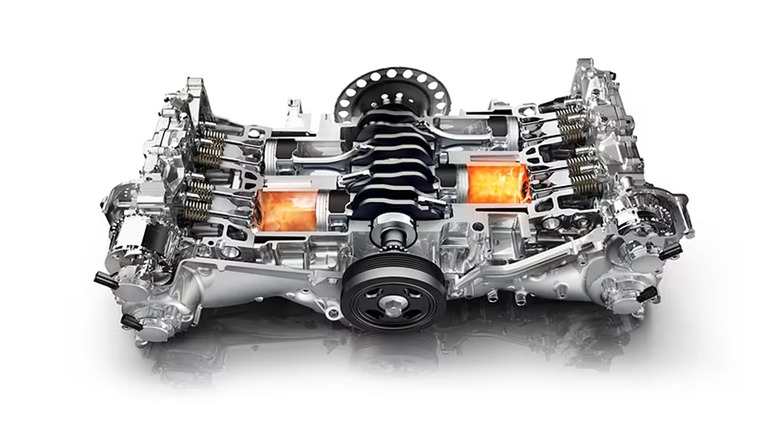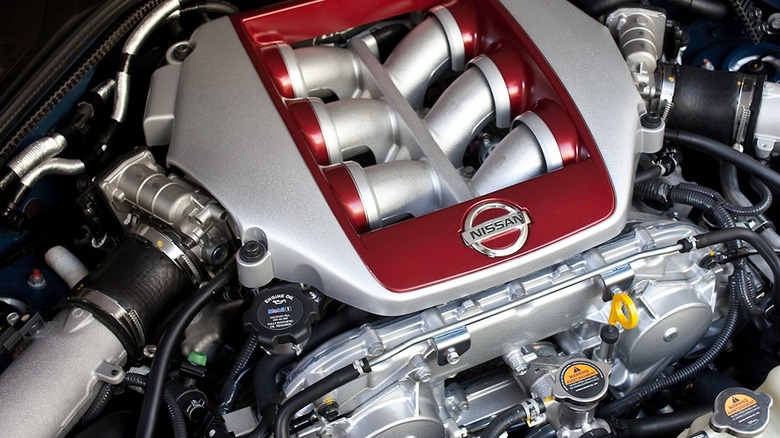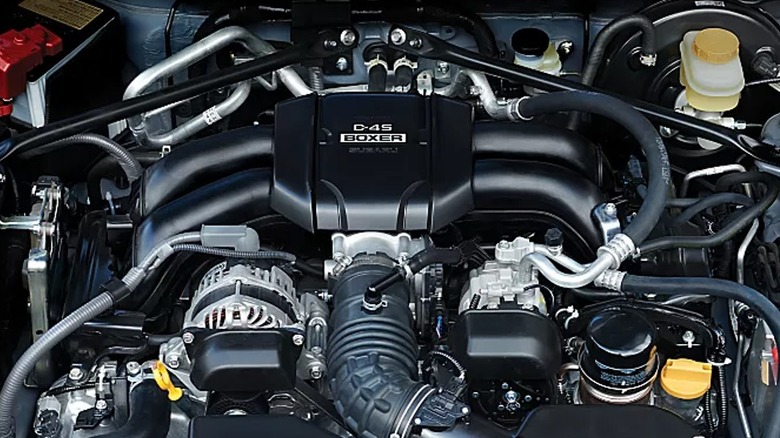H4 Vs. V6: What's The Difference Between These Engines?
Subaru is known for its four-cylinder engines, BMW for its six-cylinders, and Chevy for its V8s. There is a reason why there are so many different engine types on the market, and that's because each has its pros and cons. More cylinders often mean more power, but it also means more complexity. Fewer cylinders generally mean less power but reduced complexity and size. While additional cylinders were critical to a high-power engine decades ago, engine technology has reached a point where four-cylinder and six-cylinder engines are every bit as capable as eight-cylinders once were. Due to their better packaging, relative simplicity, and improved fuel economy, four-cylinder and six-cylinder engines are far more popular in the modern age than big V8s.
The numbers back it up, too, with over 75% of vehicles on the road today using either four-cylinder engines (at 37.7%) or six-cylinder engines (at 37.6%). It gets even more intricate than that, though, as there are even variations within those engine types. While four-cylinders are often built in an inline fashion, meaning that all four-cylinders are oriented next to each other in a line, other variations also exist. The same goes for six-cylinder engines, which are experiencing a comeback as inline engines but can also be found in other arrangements.
While inline engines have a number of important benefits, including lower production costs and overall simplicity, there are a number of other reasons why manufacturers venture outside the inline formula and look at other arrangements for both four-cylinder and six-cylinder engines. H4 and V6 engines are both examples of that and have unique properties due to their size, cylinder count, and overall design.
V6s tend to be more powerful but less fuel-efficient
The main difference between an H4 engine and a V6 engine is the number of cylinders that each has. As the names suggest, an H4 engine features four cylinders, while a V6 features six. That is a very important difference for a number of reasons, with the main two being power and fuel efficiency. With all other factors remaining the same, a six-cylinder engine should, in theory, produce more power than a four-cylinder engine. Generally speaking, an engine's rotating assembly can be made lighter with additional cylinders, decreasing inertia and allowing for more revs, producing more power as a result. With that being said, performance on paper doesn't always translate to reality, and there are plenty of examples of powerful four-cylinder engines besting V6s in terms of performance.
While six-cylinder engines typically have a leg up in terms of overall power, that comes at the cost of using more fuel, which has to be pumped into those additional cylinders to facilitate the combustion process. There are other factors that contribute to fuel efficiency, though, with weight being another important consideration. Since four-cylinder engines are down two cylinders compared to six-cylinder engines, they also tend to be lighter, putting less strain on the engine to get a vehicle in motion or keep it moving. That's only a generalization, though, as other factors like aerodynamics, vehicle weight, and rolling resistance all have a part to play in fuel economy as well.
Their arrangements affect driving characteristics differently
While the discrepancy in cylinder count is the most important distinction between H4 and V6 engines, how those cylinders are arranged is just as important of a difference. Instead of using a single bank of four cylinders, an H4 engine separates the cylinders into two banks of two cylinders and lays them down horizontally, pointing them away from one another. If you visualize that in 3D space, you'd recognize that instead of having a vertical profile like most engines, H4 engines lay very flat.
For that reason, they're also often called "flat-four" engines. "Boxer" is another nickname due to the movement of the pistons resembling a boxer throwing punches. By laying the cylinders on their side, flat-four engines have a lower center of gravity, which improves chassis dynamics and handling. That also improves safety, as unlike normal engines, front-mounted H4 engines go under the passenger compartment instead of into it during the event of a front-end collision.
In comparison to H4 engines which lay along a flat plane, V6 engines have two banks of three cylinders that are separated by an angle, visually resembling a 'V'. That angle plays a very important role in a V6's engine balance, as they aren't naturally balanced like H4 engines, which inherently cancel out primary and secondary vibrations due to their layout and firing order. For that reason, most V6 engines use a 60-degree bank angle, which is the best angle to balance firing forces. However, some V6s derived from V8s are built with a 90-degree bank angle, using balance shafts to help reduce unbalanced forces. Due to the configuration of V6 engines, they tend to be much shorter and wider than an equivalent inline-six, making them much easier to package either longitudinally or transversely.


